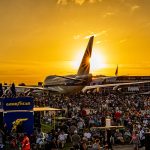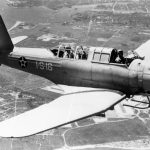The U.S. Navy’s first jet aircraft, the Ryan FR-1 Fireball, was unusual in that it was powered by a Wright R-1820 Cyclone radial engine and a General Electric J31 turbojet engine. Developed at a time when jet engines did not offer sufficient acceleration rates to operate safely from aircraft carriers, it was anticipated that the piston engine would be used for long-range cruise and the jet for combat.

The Fireball was designed and constructed by the Ryan Aeronautical Company of San Diego, California, and was first flown on June 25, 1944. Upon entering service with the United States Navy in March of 1945, the Fireball became the first US naval aircraft to incorporate a jet engine. However, the Fireball was still going through carrier qualifications with Fighter Squadron Sixty-Six (VF-66) when Japanese surrendered on September 2, 1945. The end of World War II also brought an end to production orders for the Fireball. With the rapid postwar developments in jet propulsion leading to the first pure-jet US naval aircraft such as the McDonnell FH-1 Phantom, F2H Banshee, and Grumman F9F Panther, the last Fireballs were retired from service by 1947. Of the 66 aircraft completed, only one survives today.

R-1 Fireball Bureau Number 39657 was assigned to the Ames Research Center at Moffett Field, California. Now a NASA research center, Ames was then under the National Advisory Committee for Aeronautics (NACA), the direct predecessor of NASA. There, 39657 was one of six Fireballs used for flight control testing. Upon its retirement in 1947, 39657 was then acquired by California Polytechnic State University, San Luis Obispo, where it served as an instructional airframe for aeronautical students, alongside other surplus aircraft. In 1967, Edward T. Maloney, founder of the Planes of Fame Air Museum, acquired the aircraft from Cal Poly and transported it to Ontario Airport, the then-current location of the museum. Moved to Chino in the 1970s, 39657 has now been restored to static display condition and is the last remaining example of this unique design.





























